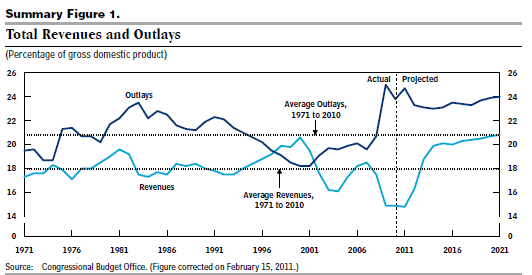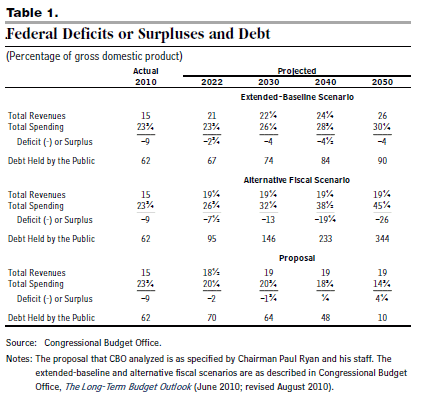Andrew Sullivan has provided qualified support for the Ryan budget, but doesn’t like the tax side, of which he says:
…the biggest flaw is the refusal to add new taxation to the proposal. Worse, it actually wants to reduce tax revenues.
I don’t think Andrew has this correct. In fact, the very large deficit reduction claims that Rep. Ryan makes in his proposal hinge on both spending cuts and a substantial increase in the total taxes collected as a percentage of GDP as compared to current levels. The portion of Table 1 from the CBO letter to Rep. Ryan makes this clear (the full table is at the bottom of the post).
In 2010, total taxes collected (income tax, payroll, corporate, everything) equaled 15% of GDP. Ryan’s deficit reduction figures are dependent upon this increasing to 18.5% of GDP by 2022, and rising to 19% of GDP by 2030 and remaining at that level until 2050. In fact, if taxes as a percent of GDP remained flat for the next 3 decades, we would have a deficit of around 3.75% of GDP in 2040 even with the Ryan budget cuts fully enacted! Thus, Ryan’s budget assumes very large increases in the aggregate federal taxes collected as compared to the status quo, putting us back in line with historical averages over the past 40 years.
Ryan proposes decreasing the top marginal tax rate and reducing the number of rate bands, while claiming to substantially increase revenue collected. There are several possibilities:
- The tax side of the plan will not stand up to scrutiny when CBO scores it
- Reductions of tax expenditures (home mortgage deduction, tax preference of employer paid health insurance, etc.) make it possible to raise this revenue
- Income taxes will rise substantially for lower wage persons (it should be noted that ending tax expenditures is generally a progressive policy since the benefit of most such expenditures disproportionately helps higher income persons, so could balance higher income taxes paid by middle/lower income earners)
- Other taxes could be raised
I take this plan as an acknowledgment that our current tax code cannot produce a balanced budget given any plausible level of spending. Increasing tax receipts to 19% of GDP would put us near the historical average in terms of tax receipts over the past 40 years as the figure from the 2011 CBO budget outlook shows.
Of course, this is still well below average expenditures as percent of GDP from 1971 to 2010, but then that is why we have only had 4 balanced budgets since I was born. To have another balanced budget before I die, I suspect it will take something on the order of at least 20-21% of GDP collected in taxes (and spending reductions from current levels) given the movement of the baby boomers into Social Security and Medicare. I am somewhat agnostic about the overall structure of the tax code, and would like to hear a vigorous tax reform discussion focused around how to best raise a target percentage of GDP. Moving from 15% of GDP to 19% of GDP collected in taxes is a step in the right direction, and it is notable to me that it has been embraced by the Republican Budget Committee chair. Democrats in the House are apparently going to release an alternate budget, and hopefully a useful debate will ensue, both about the level of taxation needed over the long run, as well as the makeup of the tax code.
Update 2: The House Progressive caucus with the outline of a budget that provides quite a contrast to Ryan’s, aiming for balance at tax receipts at 22.3% of GDP in 2021 (Ryan’s would get balance at 19% of GDP). This would include increases in top marginal income tax rates, raising the wage limit to which the Social Security payroll tax would apply to the 90th percentile of wages, and eliminate the taxable max on the employer side. More on this later, but the Deficit Commission with balance point at 21% of GDP for balance around 2035, is where you would expect it to be; in the middle. It will likely look better and better on the policy merits over time. Not sure about the politics.
Update: Austin sent me a longer time series of taxes collected as percent of GDP.





